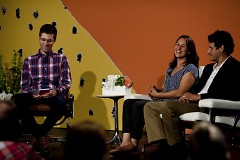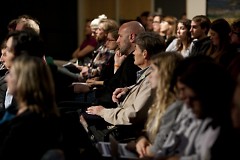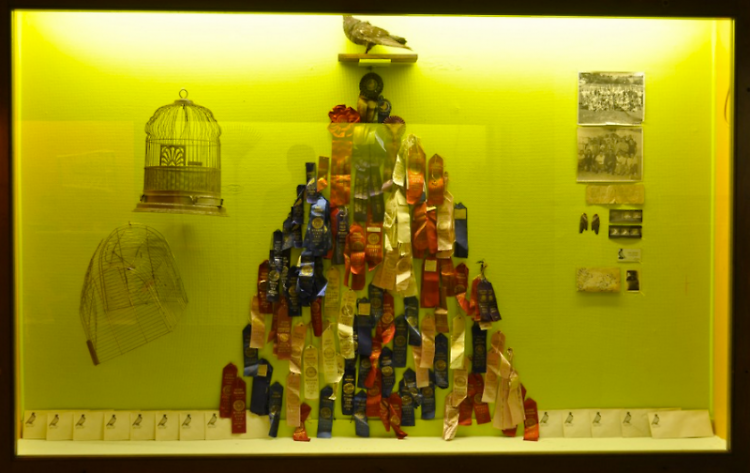
Design 99 founders, Gina Reichert and Mitch Cope, with moderator Kevin Buist, Exhibitions Director /Eric Tank

Design 99 spoke to a full crowd Tuesday night /Eric Tank

Design 99 won the Juried Grand Prize in 2012 /Courtesy of ArtPrize
Mitch Cope of Design 99 speaks almost reverently of opening an envelope he found in the attic of 13208 Klinger Street in Detroit to discover two perfectly preserved pigeon wings.
“The hair stood up on the back of my neck,” he recounts. Artist Cope and his partner, architect Gina Reichert, were speaking from the stage last night at The Hub, 41 Sheldon SE, on “Creative Approaches to Detroit,” the second of the ArtPrize-sponsored Critical Discourse series. This Detroit-based team is best known in Grand Rapids as the winners of the top juried award at ArtPrize 2012 with the piece Displacement (13208 Klinger) at SiTE:LAB, 54 Jefferson. Their work has been exhibited and published internationally including Follow the Sun at the Solomon Guggenheim Museum (2013) and The Power House at The Venice Architecture Biennale (2012). The couple founded Design 99 in 2007 to “investigate new models of contemporary art and architecture practice,” according to their website.
A description and video of the Power House project introduced the audience to the goals and working methods of many of the team’s projects. An old house on the northeast side of Detroit has been reworked into a localized power grid that is an experiment in self-sufficiency. After years of prototyping and work, the couple hopes to live there this winter. The home is also a device to help empower the neighborhood with examples of creative problem solving. Although initially rather taciturn, Cope and Reichert warmed up quickly under the informed questioning of moderator Kevin Buist, Director of Exhibitions for ArtPrize.
In his discussion of Displacement, Cope relates how a friend from his neighborhood made him aware of the vacated house a few blocks away. After unsuccessfully trying to secure the house from vandals several times, Cope and Reichert started sifting through the detritus in the house only to discover a poignant history from several generations of the family who previously occupied the home. Reichert describes the moments of discovering “personal and intimate” photographs and mementos as an opportunity for the artists to be “collectors of meaning.”
Once the decision was made to participate in the 2012 SiTE:LAB project, the duo worked very quickly; two days to bag up items from Klinger St. and two days to paint, organize, and install the materials in display cases in the former Grand Rapids Public Museum. The range of materials in their award-winning piece ranged from electronic and mechanical items to calendars to clothing. One display case exhibited dozens of award ribbons for activities involving the homing pigeons, a couple of wire birdcages, and photographs of the bird group’s activities, all crowned with a taxidermy pigeon. This project and others by Design 99 are well documented in photographs and video at their detailed website.
The colors of the display cases went from saturated and warm near the entrance to the space, to cooler and more muted further back. The ceiling was illuminated with colored neon. Reichert said the couple originally considered doing the installation on site, but it seemed disrespectful to the former homeowners. The installation in the museum cases in Grand Rapids turned what appeared to be an archeological dig into an organized, thoughtful inventory of lives come and gone. Although the age of some of the items- the children’s toys from the 1940s, for example- invited nostalgia, the overwhelming sense of the installation was of providing proof – of lives lived, time’s passing and the patina of use.
When discussing the rampant poverty in Detroit and how home values have plummeted to almost nothing, Reichert says the duo ask “What is the worth of things other than monetary?” Although she was speaking directly of the couple’s community activism in rebuilding neighborhoods, it seems that inquiry could be applied to most of their projects – both as objects useful in overcoming urban blight and as aesthetic objects in museums.
The couple often exhibits videos and documentation of their work in gallery settings like the Museum of Contemporary Art Detroit (MOCAD), where I first saw their Corner Store project. Although the building was originally purchased as a studio space for Cope, the couple un-boarded the front windows for the first time in 20 years and turned the former neighborhood Polish deli into a meditation garden with precisely raked stone patterns – a place to meditate on the life history of the neighborhood, perhaps?
Much of the resonance of this piece for me was strictly personal. My paternal grandmother ran a corner grocery store and meat market in the 1930s on Garvin St. in Hamtramck, just blocks from this location. Much of my own family’s history originated in that store. Memories of Detroit in the 50’s came to mind as I viewed Design 99’s installation at ArtX in 2013. The houses and small businesses in this urban neighborhood have cycled through each wave of new immigrants (currently Bangladeshi), their class strife and dreams of upward mobility.
And that sums up, in part, the potency of Design 99’s cultural practice. When artists can create meaningful neighborhood change and invite both solo meditation and public discussion, they are truly impacting society, allowing the audience to stand, in the words of critic Peter Schjeldahl, “for a charged moment” in each others’ shoes.
I grew up hearing “As goes Detroit, so goes the nation” As a native Detroiter, I believe in the central importance of Detroit to the state’s economy. And I remain passionately interested and ultimately optimistic about the Wild West art scene currently flourishing in the Motor City. I wonder what lessons ArtPrize can learn from Detroit and vice-versa.
While Cope and Reichert’s projects may invite such critical discourse, it seems that Critical Discourse the event does not. Although scheduled for two hours, moderator Buist ended 45 minutes early after only two audience questions. If ArtPrize does indeed want to be a place “where anyone can find a voice in the conversation about what is art and why it matters”, it seems these events would be the perfect opportunity to encourage discussion of the important issues sparked by Design 99’s innovative work. Are we too midwest polite to ask the tough questions about the efficacy of art, especially as it is consumed in ArtPrize? Certainly there are thoughtful and civil voices out there anxious to be heard.
The Rapidian, a program of the 501(c)3 nonprofit Community Media Center, relies on the community’s support to help cover the cost of training reporters and publishing content.
We need your help.
If each of our readers and content creators who values this community platform help support its creation and maintenance, The Rapidian can continue to educate and facilitate a conversation around issues for years to come.
Please support The Rapidian and make a contribution today.